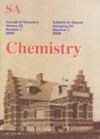废机油孔径改性烟煤碳分子筛的制备及表征
IF 1
4区 化学
Q4 CHEMISTRY, MULTIDISCIPLINARY
South African Journal of Chemistry-Suid-Afrikaanse Tydskrif Vir Chemie
Pub Date : 2019-01-01
DOI:10.17159/0379-4350/2019/V72A3
引用次数: 0
摘要
以烟煤为原料制备了碳分子筛(CMS)。通过化学活化煤制备初始活性炭(AC)样品,然后通过热处理工艺和废机油积碳制备CMS样品。通过对废机油进行热解,使其在煤基活性炭孔口沉积碳,从而得到CMS。研究了反应温度和保温时间对CMS的比表面积、微孔体积和孔径的影响。反应温度分别为400、550和700℃,保温时间分别为30和60 min。采用bruauer - emmet - teller (BET)法计算表面积,采用Dubinin-Radushkevich (DR)法和Horvath-Kawazoe (HK)法测定AC和CMS的微孔体积和孔径。在700℃的反应温度和60 min的保温时间下,获得了最大的BET比表面积(5.824 m2 g-1)、DR微孔体积(0.172 cm3 g-1)和HK孔径(6.317 A)的CMS样品。此外,还在AC和CMS上对苯和邻二甲苯的混合物进行了分离苯的分子筛分能力测试,其中CMS的选择性苯吸收率为61.36%。关键词:活性炭,碳分子筛,积碳,反应温度,保温时间本文章由计算机程序翻译,如有差异,请以英文原文为准。
Production and Characterization of Carbon Molecular Sieves from Bituminous Lafia-Obi Nasarawa Coal by Pore Size Modification with Spent Engine Oil
In this work, a carbon molecular sieve (CMS) was produced from a bituminous Lafia-Obi Nasarawa coal. An initial activated carbon (AC) sample was prepared via chemical activation from the coal, from which the CMS samples were then produced through heat treatment processes and carbon deposition fromspent engine oil. Spent engine oil was pyrolyzed in order to deposit carbon at the pore mouth of coal-based AC to yield CMS. The effect of reaction temperature and holding time variation on the surface area, micropore pore volume and pore size of CMS was studied. Reaction temperature was varied at 400, 550 and 700 °C while holding time was varied at 30 and 60 min. The Brunauer–Emmett–Teller (BET) method was used to calculate the surface areas, while the Dubinin–Radushkevich (DR) and Horvath-Kawazoe (HK) methods were used to determine the micropore volumes and pore sizes of the AC and CMS, respectively. The CMS sample with the largest BET surface area (5.824 m2 g–1), DR micropore volume (0.172 cm3 g–1) and HK pore size (6.317 A) were obtained at 700 °C reaction temperature and 60 min holding time. In addition to this, a molecular sieving ability test to separate benzene from a mixture of benzene and o-xylene in solution was carried out on the AC and CMS, with the CMS having a selective benzene percentage uptake of 61.36 %. Keywords : Activated carbon (AC), carbon molecular sieves (CMS), carbon deposition, reaction temperature, holding time.
求助全文
通过发布文献求助,成功后即可免费获取论文全文。
去求助
来源期刊
CiteScore
3.10
自引率
0.00%
发文量
6
审稿时长
>12 weeks
期刊介绍:
Original work in all branches of chemistry is published in the South African Journal of Chemistry. Contributions in English may take the form of papers, short communications, or critical reviews.

 求助内容:
求助内容: 应助结果提醒方式:
应助结果提醒方式:


